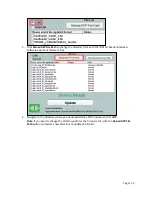
Page | 16
7
Base Functionality
7.1
PIN Pad function
•
PIN MK/SK, DUKPT Key Management
•
TDES Encryption (keystrokes are not sent in the clear)
•
4 x 4 key layout with 0-9 numerical keys, *, #, Cancel, Clear, Enter, Blank, and 3 additional
Function keys adjacent to the bottom of the LCD screen: F1, F2, F3 (function defined by
application)
•
Supports clear text entry
•
PCI-PTS 4.x certified
7.2
Interface function
•
USB-HID and RS232 interfaces connect via one DB9 connector on the back of the PIN pad that
plugs into the appropriate interface cable.
•
The L100 supports both USB-HID and RS232 interfaces for the regular host.
RS232 :
•
Baud rates supported: 2400, 4800, 9600, 19200, 38400, 115200 bps
•
Data bits: 8
•
Parity: Odd, Even, or None
•
The COM default settings are initialized to: 38400, 8, 1, & None
USB-HID:
•
PID: 0x1050
•
VID: 0x0ACD
7.3
Key injection function
•
Compatible with FutureX SKI 9000 HSM for PIN Key Injection
.
•
Can communicate with HSM using the key injection protocol for unattended products.
7.4
Low-Power Modes
7.4.1
Sleep Mode
While using the RS232 interface, Sleep Mode is controlled by a timeout after the L100 is idle for a
specified time (default is 120s). While using the USB interface, Sleep Mode is controlled by the USB
suspend and resume signals. Sleep Mode is used for battery-operated and solar-powered systems. It
reduces power consumption to a much lower level (1 mA USB, 8 mA RS232) than full-power mode (200
mA) but leaves the device able to be woken up by key press or communication from the host.
7.4.2
Stop Mode (20 µA)
Stop Mode is controlled by the application through a specific command. Stop Mode reduces power
consumption to the lowest possible level (20 µA). An L100 in Stop Mode can only be woken up by a
physical key press.
7.4.3
Bootloader function
The firmware can be upgraded via USB/RS-232 port (Baud rate is 115200).
For detailed information, please refer to document P/N 80000420-001,
Bootloader Firmware
Specification (V52).doc
.









































